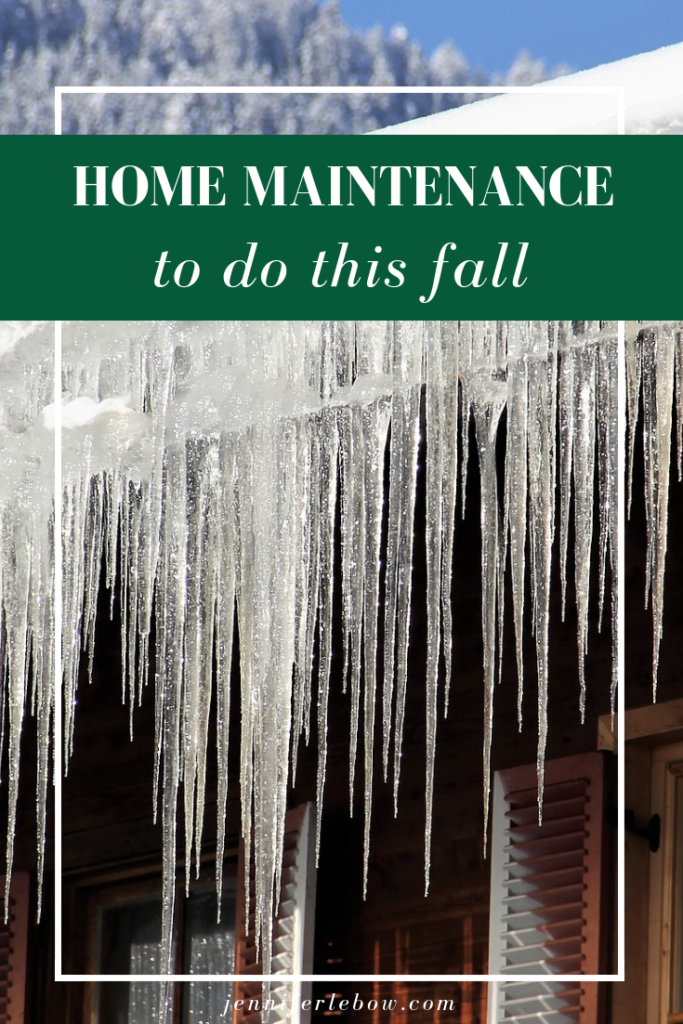
Face it. Summer is over. As you spend less time outside, don’t forget that your house still has to brave the elements during the colder weather. Use this checklist (as a start) to be sure your property is in good shape for fall and winter:
1. Clean your gutters.
At my house, this task is usually done no fewer than three times each fall. We have lots of trees and lots of rain. As soon as my husband sees rain water splashing around the roof or on the ground (because it’s missing the downspout), he yells, “Call Ed!” Ed is our trusty gutter cleaner. Remember that clogged gutters are a major contributor to roof leaks. If they are plugged and standing water turns to ice, that ice expands and can do even greater damage to the roof.
2. Check windows and doors for weather stripping.
Go around to all of your windows and exterior doors to make sure you don’t detect air flow that indicates a poor seal. Weather stripping or caulking may be in order, depending on the specific cause of the air leak.
3. Drain and turn off outdoor faucets.
The last thing you want is a burst pipe and having to replace hoses because you didn’t drain them is a drag. It takes very little time and no special expertise, so definitely make sure to take care of this item!
4. Bring inside outdoor furniture, toys, planters, etc.
Clearly, things like installed swing sets will remain outside permanently, regardless of whether they will take a beating due to winter weather. However, certain lightweight garden furniture, ornaments and flower pots should be brought inside to extend their lives. If you don’t have a place to store them, consider at least tarping them to provide a layer of protection.
5. Look for peeling paint and stone/driveway cracks.
Paint protects wood from moisture penetration. If you have chipping or peeling paint, you should take care of it before winter sets in. Any mortar pointing that needs attention or cracks in stonework or macadam should be addressed in the fall. Remember what happens when water penetrates a crack and then turns to ice? Expansion. Those cracks will just become larger and more costly to repair if you don’t fix them. Consider the chimney, too–it may not be in your line of sight, but it’s a common area for mortar deterioration and water penetration.
6. Attend to the property itself.
Fall is the best time for fertilizing and planting grass. It’s also time to plant bulbs and some perennials for a lovely spring and summer garden. What about the leaves? If you don’t remove them, they prevent sunlight from reaching the grass and you’ll have an unhealthy, brown lawn in the spring. Tree work shouldn’t be ignored either. Yes, it’s costly. It’s an even bigger nightmare, though, when rain, wind and heavy snow snap branches that fall and cause damage. Even worse, dead or sick trees that may fall through a roof in a winter storm can be responsible for tremendous damage and even the hassle of having to be out of your home.
7. Tune up, test out, replace.
Any snow blowers or other winter equipment has probably not been glanced at since it was last used the previous winter. You don’t want to discover it needs a tune up when you try to use it after a 6″ snow dump. Take care of that now. You might also want to contact a service provider for snow removal and make sure you have salt or ice melt and a snow shovel. Test out generators, any emergency radios, flashlight, etc. that you might need to rely on in case of a power outage. Have your heater serviced to make sure it isn’t about to give up the ghost. Fall is also a great time to replace heater filters, batteries in flashlights and smoke detectors, and light bulbs so your house is not dim and dreary during the dark winter days and nights.

